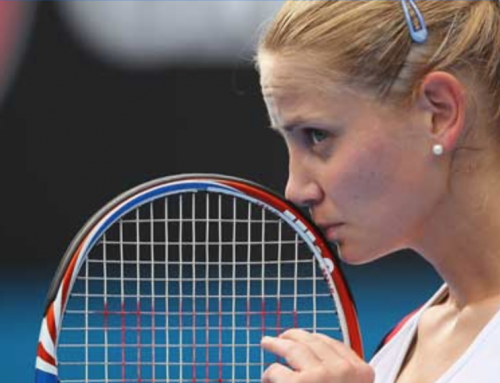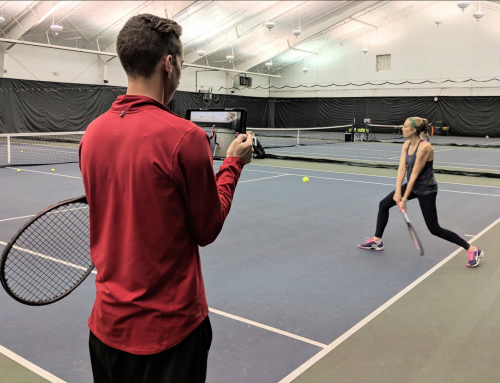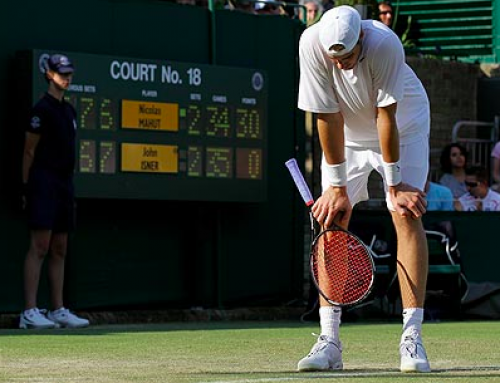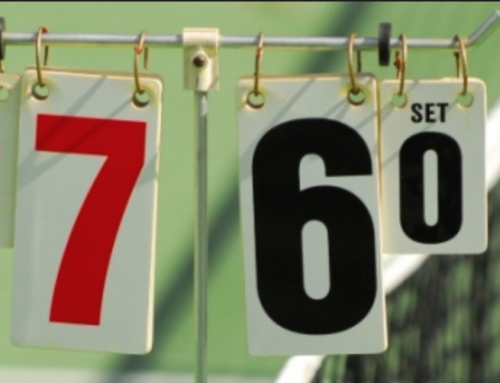smart_
If you play any doubles at all then you need to be familiar with the I formation! In today’s episode of the podcast my guest is friend and former teammate Jason Cole. Together we go over a full overview of how to use the I formation, when it’s typically most successful, how to manage signals, what parts of the court both players should be covering, and more! Start using these tactics right away so confuse and intimidate your opponents, it’s really a lot of fun!
Download Transcript: Word Doc | PDF | Kindle | Text
Welcome to the Essential Tennis podcast. If you love tennis and want to improve your game, this podcast is for you. Whether it’s technique, strategy, equipment, or the mental game, tennis professional Ian Westermann is here to make you a better player. And now, here’s Ian.
Ian Westermann: Hi and welcome to the Essential Tennis podcast, your place for free expert’s tennis instruction that can truly help you improve your game. Today’s episode of the podcast is brought to you by Tennis Express. Please check them out this week by going to EssentialTennis.com/Express.
Well thank you very much for joining me on today’s episode of the podcast. It’s going to be a replay of a little bit older episode, #55, and it’s a really good episode I had with Jason Cole, a good friend of mine and college teammate. And we talk about doubles and using the I formation, which if you’re a doubles player you need to know how to do it. We talk about when to use the I formation, the strategy of it, how to use hand signals, etc.
The reason why I’m doing a replay today is I have so much work to do and I’m behind getting ready for the release of Complete Tennis Fitness, the comprehensive tennis fitness training course that Steve Beck and I are coming out with a little later this week. And if you haven’t already looked at our free fitness course that we’ve been releasing over the past week, you need to do that right away. It’s only going to be available until July 27th, which is two days from now. So go check that out. There’s three videos. You’re going to learn about speed and quickness, strength and flexibility, how to increase all three of those things in your tennis game. It’s really valuable stuff and totally free course. Again only until July 27th so go check it out. If it’s after July 27th and you’re really serious about playing your best tennis and reaching your potential on the court, I really urge you to go check out the full course at CompleteTennisFitness.com. It’s a 19 week fitness program. It’s been designed by Steve, a certified personal trainer, to be tennis specific. And it’s a totally guided course by Steve and myself. All 19 weeks we will hold your hand through the entire process. We’re going to be right by your side. That’s better.
We’re really looking forward to working with those of you who sign up. It’s going to be great. As with all the courses I do online, there’s a money back guarantee. And also you can download everything to your computer and continue to go over it and back through the course again as many times as you’d like in the future. Really good stuff. With that let’s get to my conversation with Jason. Sit back, relax, and get ready for some great tennis instruction.
Hi, Jason. How are you?
Jason: Doing very well. Yourself?
Ian: Very well. Thank you. I’m very happy to have you back on the show. We’ve had several great conversations having to do with tennis strategy and technique. Today’s topic I know is something that we’re going to enjoy talking about we’ve done it together successfully quite a bit, and that is the I formation in doubles. I know you’re looking forward to talking about this.
Jason: I love it.
Ian: This topic came to us from Sally. Here’s her question. She wrote, hey Ian in doubles are you a fan of the I formation? Have you ever talked about formations in your podcast? In doubles if our opponents have won a few points in a row and seem to be getting into a winning groove with their confidence, as a server I love to break up the momentum by throwing in the I formation. However I’m not sure if I’m doing it correctly. Is there a good or bad time to use an I formation? Where should I serve? Should I serve down the T to their weaker side into the body? And lastly she says, after I serve should I come in or stay back? I tend to stay back and watch to see what happens with the return. Is this okay? I’d love to know your thoughts on formations and whether you use them in competition and what it takes to win.
Sally, we’re going to talk about all this today and even more. We’re going to get pretty in depth with this, and Jason and I are going to talk about all the pros and cons of the I formation and the Australian formation as well. We’re going to talk about when to use each of them, how to execute them, and even we’re going to talk about how to defend against them as well. Jason, let’s start off with I formation.
Jason: Yeah. I use it in pretty much every competitive doubles match that I play in.
Ian: Nice. Let’s start talking about when to use it. So we’re playing a doubles match. Let’s just assume that you and I are playing together. If you and I were competing against another team, when would be a good time for us to throw that in? When would not be a good time? Let’s start with when would be a good time.
Jason: Pretty much any time is a good time. If you’re rolling over your opponents, then perhaps it’s just not necessary. Keep doing what works, but there’s to doing it before they ever get in a groove. Certainly if they’re in a groove, then that’s a good time to use it. It’s hard to pick a bad time to use it. One of the beautiful things about it is it keeps them guessing.
Ian: Yeah. The I formation is a great way to break up your opponent’s momentum and really keep them guessing and keep them off balance.
Jason: When you have a decent player who knows he has the entire cross court to hit it to, you’re going to get broken a lot. You have to make them feel like you might come into play somewhat. So whatever way you can do that whether I formation, approaching a lot, or whatever. It’s got to happen. I feel like so many times at the 3.5 or 4.0 level it’s just accepted that the serve goes in, the return goes cross court, and then we play the point. To me that’s a terrible tragedy.
Ian: I agree. We’re trying to break up the momentum of the returner. We’re trying to make the return as uncomfortable as possible. We want to get in their head not in a gamesmanship kind of way and be obnoxious about it, but maybe a little bit. We want to get them guessing and really make them feel like they can’t take anything for granted. At any given point, the net player might be going one way and we’re going to make them uncomfortable. So let’s talk about how to execute it, and in general we want both players — the I formation obviously refers to both players being kind of right in the middle of the court and having them both start from that position. So we have the net player basically right around the center service line, and the server pretty close to the hash mark kind of serving from a singles position. So what about the lob, Jason? Sally in her question mentioned that she was staying back. We’ve gone over this briefly in other shows where you and I have been talking about doubles, but what do you think about the fact that Sally was saying back? I would assume probably that to get to get a feel for the point and see if they’re going to drive, how easy of a time your partner is going to have at that net, do you think she should be staying back to cover that?
Jason: No. It depends Sally on how good your partner is. Hopefully your partner is a monster up there and going to go for about everything, but you should try and move it to where you know your partner is not going to cover. If you’re staying back, you’re pretty much allowing them to lob and then take over the net while you’re forced to stay in the back court, which is obviously not a situation you want to be in.
Ian: I agree. And Sally let me encourage you along with Jason here to get to the net. You want to be up there with your partner as soon as possible. We’re trying to just smother that net and put a bunch of pressure on our opponent. We want to finish the points in our favor, clearly, as often as possible and quickly as possible. So don’t stay back and just kind of be passive and wait to see what’s going on. Clearly we’re putting our partner up there close to the net right away because it’s a good thing. We want them up close so we can try to win the points quickly. If you stay back, you give your opponents a spot on the course where they can get it there, meaning your side of the court, and now they’re in control again. They have the time to move in if they want to. In doubles in general, Jason and I are going to both tell you as much as possible get to the net as often as you can.
As Jason was saying, a lob in an upper level player’s mind is the best thing possible. When we see a lob, we’re licking our chops immediately.
Jason: Yeah. If you’re scared when an overhead goes up, then you need to work on your overheads before you worry about formations and doubles in general. This is a different podcast, but when an overhead goes up, that point is over. At least you’re in heavy command, so yeah that should not be something to worry about hopefully.
Ian: I agree. Well, let’s talk about signals. Jason, we have the net person going one way or the other. How do we figure out exactly what play we’re going to be using from one point to the next?
Jason: Well, that’s the next thing. Two quick things on that. For one, the server has got to know what way his net man is going otherwise you’re standing directly behind them. Pretty easy to get beat that way. So you’ve got to be making a signal somehow. There’s a bunch of ways you can do it. I use my pinky, thumb, and middle finger for a body serve. Obviously we can figure that out. Pretty simple. Or you can just back up and talk to your partner. But if you don’t know where’s going, there’s going to be some issues.
The second important thing is remember you’re forcing people to do a really hard thing, which would be take a ball from the middle of the court and somehow hit it down the line. You’re forcing them to hit a really sharp inside-out angle because they’re scared of your net man. So they’re going to make some of those. Keep in mind when they do hit an amazing return, that’s part of the game. That’s the percentage, and you’re hoping that you’re not playing someone good who can do that and hit a high percentage.
Ian: Sure. In which case you’re pretty much going to have to say good game. Let’s talk about covering the court, and this is something that I feel, I get the sense it’s probably going to be one of the more important things we go over Jason. So let’s discuss a specific instance, specific circumstance here. Let’s say we’re playing a point. I’m serving. You are up at the net, and we’re in an I formation just we talked about. I’m going to be right up to the hash-mark in the middle of the baseline. You the net player are going to be pretty much right over the center service line, and I’m going to serve down the T. Now you said a second ago3 that when doing the signs and talking beforehand setting up the points. Let’s say I serve at the body, and Jason had told me that he was going to stay right there in the middle. So I know that some listeners are hearing that and saying, well if Jason stays right in the middle of the court, doesn’t that mean that the returner is going to basically have an equal shot in either side of the court because Jason is standing in the middle. They could hit to the right or left of him. But Jason I know you’re saying that’s not true. Can you please explain? If you stay in the middle you’re actually covering one whole half of the court, and which half is that?
Jason: Well I’m actually covering about 70% of the court if I’m in the middle there, and it would be the cross court half which is the easier half for them to return on. Primary reason for doing that formation is everybody is good at hitting cross court returns. So you want to take that away the majority of the time. It’s also the easier one to cover because it’s the closest side to you.
Ian: When we’re in that situation serving from that I formation and Jason pops up and he’s right in the middle of the court and close to the net, because the returner is over on the deuce half of the court, he is covering primarily a cross court shot. By taking one step to his left, he could probably cover a good amount of down the line shots as well, anything that goes actually in the alley or his left, that’s what I’m covering. And that’s what we’re talking between points is who is going to cover which side. But it’s very important that this is such a huge advantage because Jason is automatically in a position to cover a ton of the court, but the biggest part he’s covering is as he’s saying is the easiest spot to hit, cross-court. It’s where the net is lowest, court is longest. It’s what everybody practices hitting.
So if you and your partner can setup this formation, and if your partner can place the ball down where the ball is going to be right in front of you, and if you can pop up close to the net right around the center line, you’ve got a huge advantage going into that point assuming that your partner is doing their job and hussling over to the left incase your opponents do hit down the line. We’ve got a big advantage going into that point.
Going back to the signs and talking between points, I would encourage you guys to use both. It’s good for your partnership if you guys just talk between every point. Get a feel for what both people are feeling and how they’re feeling about how the points are going. Get each other’s feedback about strengths or weaknesses that you guys might think that your opponent’s have, and really work as a team between every point. It doesn’t mean that you sit and talk every 2 minutes, but exchange a few words back and forth and do your signals.
Jason: One of the worst ways you can lose points is I tell you I’m staying, and the guy hits a crappy return down the line but you’re not there because you thought I was going right, which somehow got confused. That’s a painful way to give up points.
Ian: I completely agree. Alright let’s quickly touch on Australian formation. This is another formation you guys can use as well. And the difference between I formation and Australian is the net player isn’t in the middle of the court. They’re not close to the service line. They’re actually covering all the way over on the opposite side they normally would to fully take that just the cross court half of the court. So if Jason and I were playing on the deuce side, the server would still be pretty close to the hash mark. And server’s partner would be in the deuce side service box as opposed to the ad side service box, which is a standard formation. And when would we want to pull this out, Jason?
Jason: if the cross court return that they’re hitting is just still too good for your position, whether you are not fast enough or their return is just incredible cross court, that would be a good situation to be in because there’s no way they can get it past you cross court when you start over there. In addition I’d like to say that you still are definitely more towards that center line than you would be in a normal position. I’d say maybe 3 feet away from the center line. Not right in the middle of the box.
Ian: So basically guys this is just another tool in your toolbox. Just another way to mix things up and adjust based on your opponent’s strengths and weaknesses. And when you find something that works, just keep hammering away at that strategy, that same setup of shots again and again, and you make them adjust in some way and come up with a better shot or strategy.
Jason: With the people that I teach, even the very lower level ladies, if you’re at net and you don’t hit any return to help your server, you’re kind of useless out there. So it’s hard for those ladies and most people to get two out of four balls if they’re just standing there.
Ian: Yeah. That’s pretty classic like 3.0 level response is the one player will be at the end and just stand there and literally turn back and forth and watch the ball go cross court back and forth, and after the partner’s serve gets broken they complain that their partner’s serve got broken. And they’re standing up at the net not doing anything at all to help them out. In high level doubles, a lot of times the net player has more to do with holding the serve than even the server does. You need to play a strong supporting role there and help them out as much as possible.
Well, we’re going to wrap things up. Time just flew by, Jason. Any last thoughts before we sign off?
Jason: I’ll just say if I get broken, it’s your fault Ian.
Ian: Fair enough. It’s my fault. Alright, Jason, thanks for joining us and great conversation there about I formation and Australian formation as well. Always a pleasure to have you on the show.
Alright. That does it for episode number 180 of the Essential Tennis podcast. Thanks very much for listening. Hope that you enjoyed my conversation with Jason. I need to get him back on the show again. It’s been a while since I’ve had him as a guest, but I really enjoyed talking with him because he’s very knowledgeable and very honest. So thanks again for listening today, and make sure to go to CompleteTennisFitness.com this week. Get the free course before it goes away on July 27th, and if you’re interested in joining Steve and I inside the full course, also go to CompleteTennisFitness.com. Again, 19 week fitness program designed specifically for tennis players. Can’t wait to get started. With that, going to wrap up for this week. Thanks very much for joining me. Take care and good luck with your tennis.







